The Ultimate Guide to Designing Large Bird Aviaries
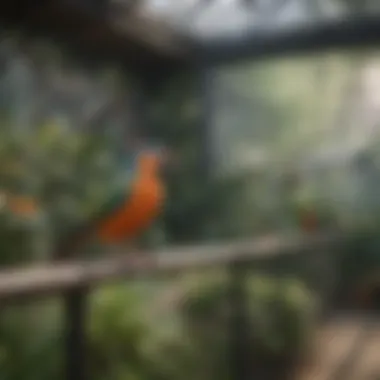
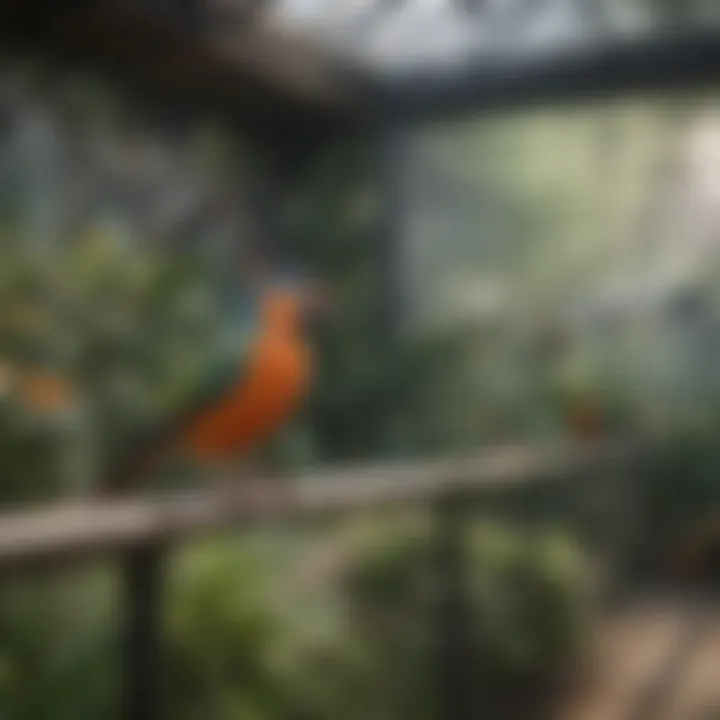
Intro
Large bird aviaries offer unique opportunities for both the birds themselves and their owners. They create vast spaces for avian inhabitants to engage with their environment, fly, and socialize. Creating an aviary is not just about dimensions and materials, but also involves understanding the particular needs of various bird species. Generally, a large aviary promotes better health, reduces stress, and enhances overall behavior within birds. This section will outline vital details essential for those considering or maintaining an aviary for their feathered friends.
Care Tips
Creating an ideal living environment requires proper care and planning. The daily routines of caring for birds must be well-defined, allowing for a comprehensive approach to their well-being.
Daily Care Routines
A well-organized routine is crucial to ensure birds thrive in a large aviary. It must include the following tasks:
- Feeding birds fresh, clean food and changing water daily.
- Monitoring for any signs of distress or illness.
- Replenishing toys or changing out enrichment items periodically.
Allocating sufficient time for observation each day can significantly improve the bond with birds.
Cage Setup and Maintenance
A successful aviary must also have effective setup and prudent maintenance.
- Making sure all perches are appropriate for the bird species considering their size and natural habits.
- Using durable materials for construction. Stainless steel or weather-resistant woods are favorable. Ensure good access doors for cleaning and maintenance.
Periodic adjustment of perches and bedding maintains variety and cleanliness.
Hygiene and Cleaning Practices
AVIARY hygiene significantly contributes to the health of the birds. Cleaner habitats lead to happier birds.
- Daily spot cleanings of waste are essential. If left unattended, bacteria can grow quickly.
- Weekly deep cleanings involve removing all items from the aviary. Scrubbing surfaces and changing all bedding improves sanitation.
Seasonal Care Adjustments
As seasons change, so do the needs of the birds. Temperature control is paramount. In winter, special attention ought to be paid to heating and insulation. Monitor them closely for changes in behavior.
During summer months, ensure there is enough shade and cooled areas, as many birds suffer from heat stress. Adjustments to diets may also be agreed seasonally.
Behavioral Insights
Understanding bird behavior is essential for maximizing their well-being within an aviary. Knowledge of their non-verbal communication can foster better overall environments, leading to less stress for the inhabitants.
Understanding Bird Body Language
Birds express a myriad of emotions through body posture and vocalizations. Paying attention to details like feather ruffling or head movements aids in comprehending their moods correctly.
Common Behavioral Issues and Solutions
Identifying behavioral issues like aggression or excessive plucking is vital. Solutions require patience. Providing ample enrichment can often mitigate unwanted behaviors.
Positive Reinforcement Techniques
Using positive reinforcement techniques acknowledges desirable actions. For instance, rewarding birds for exploring new spaces fosters curiosity.
Social Interaction Needs
Many bird species display social tendencies. Ignoring their need for socialization may lead to anxiety or depression. Consider socializing them with other birds or spending more time conducting interactions.
Nutrition Guides
Avian diets must be varied that suits their specific needs. Essential components must always be catered to each species of bird, while ensuring all food is safe.
Essential Diet Components
Just like any other pets, a balanced diet includes several components such as seeds, nuts, fruits, and vegetables. Research individual dietary needs depending on species.
Safe and Toxic Foods
Understanding what food is toxic to birds remains critical. Common everyday items like avocados, chocolate, or fruit seeds can cause health issues. It's important to have an up-to-date list for reference.
Supplements and Treats
Consumers can offer specialized supplements. Probiotics could improve digestion. Occasional treats foster relationships but must be given in moderation.
Feeding Strategies for Different Species
Different birds have unique feeding strategies. It's insightful to observe their habits. For instance, larger parrots may prefer to forage, while smaller birds may want quick access to grains nearby.
Wellness and Health
Routine health checkups are crucial in an aviary to catch any issues before they develop into severe problems. Never ignore symptoms as they may point to underlying health challenges.
Routine Health Checkups
Participating a vet with avian experience makes a difference. Monthly inspections for physical health ensure problems are spotted early, broadening overall longevity.
Identifying Symptoms of Illness
Birds often hide their illnesses. Be alert for changes in eating, droppings, or otherwise yawning frequently. Consult an avian vet for detailed advice whenever you’re unsure.
Preventative Care and Vaccinations
Before illness strikes, preventative care plays a critical role. Vaccination records must be kept aligned with any recommended protocols. Meeting additional nutritional needs promotes optimal health too as birds get older.
Mental and Emotional Well-being
Birds benefit from structured environments and companionship, which serves as the foundation for their mental stability covering a wide range of conditions. Interactive items, such as toys for chewing can help sustain overall well-being.
Enriching Activities
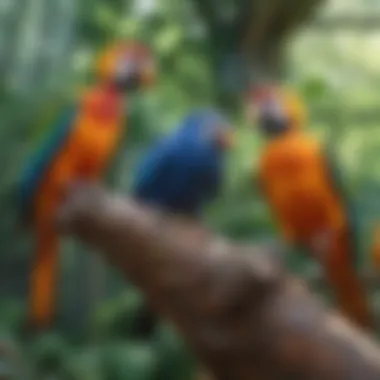

An engaging aviary experience takes forethought, but it also fosters relationships and wellbeing.
Toys and Playtime Ideas
Incorporating ample diversity in toys sparks interest and reduces stress. Rotating sets of toys keeps the environment dynamic.
Training and Tricks
Allowing birds to learn tricks can enhance engagement. Simple obedience could procure satisfactory interaction and excitement for both bird humans alike.
Outdoor Activities and Interaction
Some social interaction heightens emotional quality of life. Structures designed specifically for monitored play outdoors could aid enjoyment.
DIY Projects for Mental Stimulation
Creating enriching DIY projects targeted at aviary inhabitants requires creativity yet encourages birds to explore more freely without the risk of changing harm.
“Each breed manifests different needs, attuning methods that promote mental and emotional gains betters aviaries overall strata.”
Through careful planning and detail orientation, communities of bird owners forge high satisfaction facilitating layered hobbies around caring for their vibrant companions.
Intro to Large Bird Aviaries
Creating a large bird aviary is a commitment that demands understanding of various components that contribute to a bird's well-being. Capturing the essence of aviary fabrication requires focusing on not just the physical structure but also the holistic environment that nurtures its feathered inhabitants. This section serves as a foundation for aviary enthusiasts, delineating essential aspects’s that should form the bedrock of aviary enthusiasm.
Defining a Large Bird Aviary
A large bird aviary is typically characterized by spacious enclosures that accommodate a variety of bird species. Unlike cages, aviaries provide more freedom for birds to fly or glide. This spill of space leads to natural behaviors being expressed. Distinguishing a large bird aviary necessitates mention of three critical aspects: size, height, and design complexity. Weatherproofing baking sections offers ideal outlets for birds. The choice of materials, configuration, and decorating should promote both aesthetic appeal and comfort. Ultimately, it's about creating a habitat that mirrors an avian’s natural surroundings.
Importance of Aviary Spaces
Aviary spaces are recquired zones tailored for promoting a group of key physiological and psychological needs for birds. One core benefit is increased winged liberation which leads to stronger muscles and enhanced coordination. Furthermore, space allows for more interactions with other birds, facilitating social and cognitive stimulations. Even more, larger habitats might set the stage for accomplishing breeding successes through consultations among various species. Smaller, more cramped containment creates stress and loneliness which alters a bird’s inherent personality. It is, therefore, imperative for anyone who wishes to observe-successful behavior variety to delve into aviary expansions.
Key Considerations for Designing an Aviary
Designing a large bird aviary involves various key considerations. Each aspect is essential for ensuring both the well-being of the birds and the practicality of the space for their caretakers. A thorough approach means considering the bird species, space requirements, and environmental factors. Taking these into account supports optimal living conditions, which ultimately leads to healthier, happier birds. Let's delve into specific elements that must be examined closely in this process.
Space Requirements
Space plays a critical role in aviary design. Birds need adequate room to move freely, fly, and exhibit their natural behaviors. When designing an aviary, determining the correct dimensions is not simply about providing living space; it's about promoting well-being.
Factors Influencing Space Needs
- Species Size: Different bird species vary significantly in size. Larger birds need more space than smaller ones. For example, a macaw will require more room than a finch.
- Number of Birds: Additional space is necessary with each extra bird. Crowding can stress birds and lead to aggressive behavior.
- Flight Patterns: Plan for vertical and horizontal space. Birds should not only have room to fly forward but also to perch.
- Facilities & Furniture: Install feeding stations, perches, and enrichment items without reducing the overall space for flight.
Providing a well-thought-out design influences the aviary's effectiveness. Calculate space requirements carefully to foster a suitable atmosphere for your feathered friends.
Location and Environment
The location of an aviary affects everything from temperature control to the overall health of its inhabitants. Choose a site that provides ideal conditions for the species you wish to keep. Here are essential elements to contemplate:
Choosing the Right Location
- Sheltered Spots: Avoid placing the aviary in extreme weather areas. Protect birds from intense sunlight or wind by positioning it in a shaded location.
- Natural Habitat Mimicry: If possible, location should reflect the bird's natural environment. It helps ease stress and can invoke normal behaviors.
- Accessibility: Place the aviary where it is easy for caretakers to interact with it. This allows for efficient feeding, cleaning, and maintenance tasks.
- Noise Considerations: Bird species may react differently to noise. Select a location that minimizes stressors, understanding that some birds are more sensitive to sounds than others.
The environment encourages or stifles the birds’ behavior. A fitting location helps in the development of a healthy and vibrant aviary. By adhering to initial plans about space requirements and outdoor positioning, you can construct an aviary that nurtures its inhabitants.
Remember, the well-being of birds in an aviary cuts across multiple factors. Every design element impacts their comfort and security directly.
Materials for Aviary Construction
Choosing the right materials is vital when constructing large bird aviaries. The materials not only support the structural integrity of the aviary but also affect the health and wellbeing of the birds. Considerations include safety, aesthetic appeal, and functionality. The right materials can create a safe habitat where birds can thrive, reducing stress and preventing injury. Proper material selection fosters a welcoming environment, encouraging natural behaviors that enhance the quality of life for the avian inhabitants.
Choosing the Right Materials
Selecting materials for your aviary requires careful thought. A balance of durability and safety is essential. Here are some common materials used in aviary construction:
- Wire Mesh: Opt for stainless steel or galvanized wire mesh for durability. The gauge should be strong enough to prevent escape or entry of unwanted pests.
- Wood: Un-treated woods can be fine for perches and platforms. However, hardwoods are preferable due to their strength and resistance to rot.
- Plastic: This can be used for feeding and watering solutions; just ensure it is aviary-safe and free from harmful chemicals.
- Concrete: Useful for constructing aviary foundations, especially in areas prone to invasive wildlife.
When making a selection, always be wary of what chemicals might leach from materials. The wellbeing of your feathered friends should guide your choices here.
Durability and Maintenance
Durability is a significant aspect of aviary materials. Outdoor elements can weaken some materials quickly, adding to the maintenance workload. Numerous factors impact the lifespan of materials:
- Weather Exposure: High humidity or constant sunlight can degrade some materials, leading to replacements.
- Wear and Tear: Active birds can damage softer materials more easily. Understanding species behavior is important for selecting appropriate products.
Regular maintenance is key to prolonging the life of your aviary:
- Routine Checks: Inspect materials regularly for rust, damage, or wear.
- Cleaning: Use non-toxic cleaners to ensure hygiene without risking health.
- Repairs: Address any damages promptly to maintain safety.
By investing in the right materials and maintenance practices, aviary owners can create a long-lasting home for their birds, ensuring it remains a safe, thriving environment.
Aviary Furnishing and Layout
Creating a suitable aviary environment involves careful consideration of furnishing and layout. This aspect of aviary management supports the physical and psychological well-being of birds. The arrangement of space, coupled with appropriate elements, can significantly enhance their living experience.
Natural Branches and Perches
Natural branches and perches play a vital role in any aviary. They provide essential places for resting, climbing, and exercising. It's crucial to select branches that are untreated and free from pesticides. These natural materials help mimic the birds’ habitats in the wild. Branches of various widths encourage different grip styles, which benefits the muscle development of birds.
When arranging branches, consider the height and angle of each perch. High perches offer birds security and a better vantage point, important for species naturally inclined to roost high. Include a variety of surfaces, such as smooth and rough textures, to promote foot health through natural wear. Ensure spacing between perches to prevent overcrowding. Using softwood branches like pine or fir is a straightforward choice for perches. However, check for sap residue that could be harmful.
Features of effective branch usage:
- Varied Heights: Providing vertical space gives birds room to soar and explore.
- Different Widths and Textures: Supports foot health and muscle engagement.
- Safety First: Ensure branches are secure to prevent accidental falls.
“Properly constructed perches can lead to increased activity, reducing boredom and associated stress.”
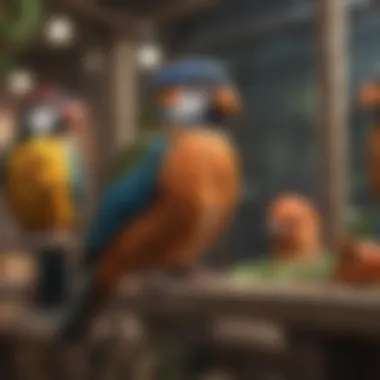
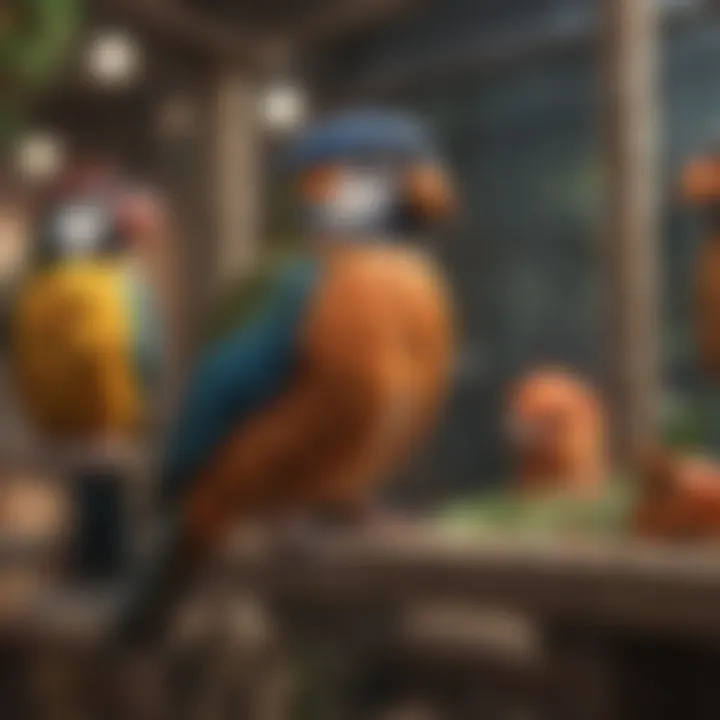
Hiding Spaces and Nesting Areas
Hiding spaces and nesting areas also contribute to the aviary environment's quality. Birds require quiet spots to retreat and feel safe. They often need a choice of spaces that provide privacy from the attention of other birds or people. Enclosures such as small boxes, artificial caves, or densely planted areas serve this purpose effectively.
When creating these spaces, use natural materials. Coconut shells or wooden boxes can stimulate nesting behavior when equipped appropriately. These areas are not only essential for safety but also can encourage positive social interactions among birds who prefer the comfort of a secure area.
Considerations for creating hiding spaces:
- Variety in Enclosures: Consider different shapes and depths to cater to various species preferences.
- Safety: All materials used should be free of harmful chemicals.
- Accessibility: Ensure that birds can get in and out of these hideouts easily for their comfort.
Alongside nesting areas, offering diverse locations for nesting can lead to more consistent breeding behaviors. It promotes the welfare of the birds while allowing them to engage in their natural instincts. Overall, the right furnishing and layout will ultimately enrich the living space for all avian inhabitants.
Environmental Enrichment in Aviaries
Environmental enrichment is crucial for the overall welfare of birds in an aviary. This concept goes beyond mere aesthetics, contributing significantly to the physical and psychological health of birds. By incorporating various elements that stimulate and engage their natural instincts, aviary owners establish a vibrant habitat.
Aviaries that lack proper enrichment can result in stress, boredom, and even undesirable behaviors among birds. Hence, understanding the importance of environmental enrichment becomes essential in aviary management, resulting in happier, healthier birds.
Toys and Activities
Selecting suitable toys and activities for birds should not be based only on appearance, but also on their benefits to avian life. Birds are naturally curious and intelligent, necessitating mental and physical stimulation.
Toys come in diverse forms, such as
- Chewing toys: Made from various materials, important for maintaining beak health
- Foraging toys: These should challenge birds to find treats, mimicking their search behaviors
- Bells and movement toys: Noises and motion can captivate and engage them actively
Incorporating structured activities like playtime and training sessions can also enrich their experience. Social play among birds provides a dynamic daily routine. The recommended approach is rotating one or two toys regularly to keep the environment fresh and stimulating for the birds.
Social Interaction and Companionship
Birds are inherently social creatures, and social interaction is paramount for their well-being. A large aviary ideally embodies this quality, offering opportunities for communication and bond-forming.
- Having birds of compatible species positively influences their happiness and social interactions.
- Engaging interactions with human caregivers also foster a sense of security and companionship.
Instead of solitary existence, enabling pair or group living encourages behavioral practices. Important factors include plenty of socializing to reduce stress among the inhabitants. With physical and social enrichment, aviary owners can create space that feels more like a natural habitat, where all birds thrive together.
Enrichment and social interaction can profoundly impact the well-being of birds, helping to assert their inherent social nature and instincts.
Maintaining a Large Bird Aviary
Maintaining a large bird aviary is crucial for ensuring the health and happiness of its inhabitants. An aviary that is well-managed contributes significantly to avian well-being. Regular maintenance demands careful attention to hygiene, health monitoring, and proper furnishing. This section will delve into cleaning and hygiene practices, as well as health monitoring for the birds in your care.
Cleaning and Hygiene Practices
Aviary hygiene affects the residents' health directly. Inadequate cleaning can lead to the buildup of pathogens that harm birds. To maintain cleanliness, aviary owners should adopt daily, weekly, and monthly cleaning schedules. Key practices to follow include:
- Regularly remove droppings from perches and flooring.
- Use safe and non-toxic cleaners for disinfecting surfaces. Avoid harming birds with harmful chemicals.
- Amend a routine that involves washing food and water containers daily.
- Ensure adequate ventilation while cleaning to avoid airborne illness.
One benefit of consistent cleaning is reducing parasites that can stress the birds. If birds are kept in sanitary conditions, they become less prone to illnesses. Taking this task seriously creates a lively and thriving environment.
"A clean platform is essential, it is the ground for well-being in any aviary setup."
Health Monitoring of Inhabitants
Monitoring the health of bird inhabitants is vital for maintaining overall aviary well-being. Early detection of health issues can mitigate severe conditions and ensure prompt care. Consider implementing the following:
- Observe daily behavior for signs of stress, illness, or changes in activity. Each bird has individual quirks; understanding these can help catch problems early.
- Conduct regular check-ups on feeding habits. Analyze what the birds consume.
- Schedule a health examination with an avian veterinarian at least once a year. Keep records of these checks for future reference.
Regular health monitoring not only aids in catching problems early but can also bring to light underlying issues in aviary management. Birds need the veterinarian’s expertise when illnesses are suspected, so it's important to establish a known relationship with one.
In summary, maintaining a large bird aviary involves strict adherence to hygiene and pro-active health monitoring. These practices influence both native health and overall happiness. Bird care is an intricate task that requires diligent effort and thoughtful execution.
Choosing Bird Species for Your Aviary
Selecting the right bird species for your aviary is a critical aspect that directly impacts the well-being of your feathered friends. Different species have varied needs regarding social interactions, habitats, and diet. Making an informed decision can lead to a thriving aviary, while mismatched species can result in stress, aggression, or health issues. This section discusses necessary considerations when choosing bird species and the factors that contribute to harmony within your aviary.
Compatibility Among Species
When multiple bird species inhabit an aviary, compatibility is essential to maintain a peaceful environment. Not all birds get along; certain species may exhibit territorial behavior and aggression. It’s vital to study both species being considered for cohabitation.
Some tips on species compatibility include:
- Understanding Natural Behaviors: Certain birds have specific behaviors influenced by their natural counterpart. For example, cockatoos often thrive in social environments, while canaries may prefer their space.
- Size Considerations: Larger birds might unintentionally harm smaller birds, so ensure the size differences aren't too extreme.
- Diet Requirements: Different species may have specialized dietary needs, leading to competition for food resources. This problem can cause stress and health concerns.
Obtaining expert advice from bird specialists or relevant literature can be beneficial. In addition, engage with trusted communities on platforms likethe reddit.com for practical advice based on personal experiences.
Social Needs and Behavior
Social dynamics among birds also play a significant role in their overall welfare. Understanding the social needs of particular species can help foster a healthy atmosphere. Birds are social creatures, and their emotional well-being influences their behavior.
Factors to consider include:
- Establish a Flock: Many parrots,_e.g., African Greys, do well in small flocks and often exhibit reduced stress when they interact with their kind. A right balance in species composition can help ensure harmonious coexistence.
- Individual Personality Traits: Just like humans, different birds have distinct personalities. Even within the same species, one bird may be more dominant.Observation is key in understanding these traits and managing interactions.
- Interactive Enrichment: Limited stimulation can lead to bored or unhealthy behavioral patterns. Provide a variety of toys and exercises to keep each bird engaged.The more they interact, the less likely they will become aggressive towards one another.
Bird care isn't a one-size-fits-all journey; engaging deeply in understanding partners ensures a nurturing and thriving aviary setup. As you consider choice, make sure to prioritize well-informed decision making through reliable resources like britannica.com.
Inavariably, choosing complementary bird species can not only prevent conflict but establishing a healthy replica of their natural habitat can enhance their overall happiness and longevity.
The Benefits of Large Bird Aviaries
Large bird aviaries present significant advantages to bird enthusiasts. They provide an environment that allows birds to thrive, promoting not just their physical health but also their mental well-being. Understanding the benefits of large bird aviaries also helps aviary owners in creating better habitat for their beloved pets. In this section, we will look into promoting natural behaviors and enhancing bird welfare associated with significant aviary spaces.
Promoting Natural Behaviors
Birds, like all creatures, exhibit various natural behaviors critical to their well-being. A large bird aviary allows for these behaviors to flourish. When birds are given enough space, they tend to engage in activities such as flying, foraging, and socializing. Such behaviors are essential for maintaining a normal life.
Enclosed spaces can limit movement. However, an aviary designed with ample vertical and horizontal space encourages movement. Thus, aviary owners can notice their birds engaging more in the following:
- Flight: Aviaries allow birds to fly rather than just hop. This mimics their natural environment, thus addressing the need for physical exercise.
- Foraging: Being able to search for food promotes mental stimulation. Aviary shelves can drift with foods placed in searching spots.
- Social Interactions: If birds live together, they are more likely to develop social bonds. This social behavior allows birds to thrive as they can communicate and play together, simulating natural flocks.
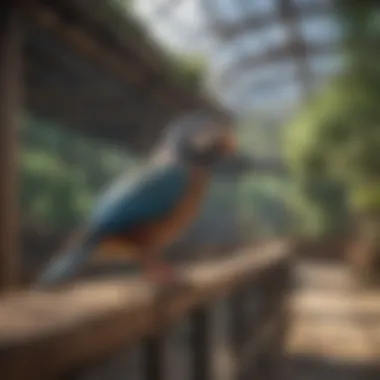
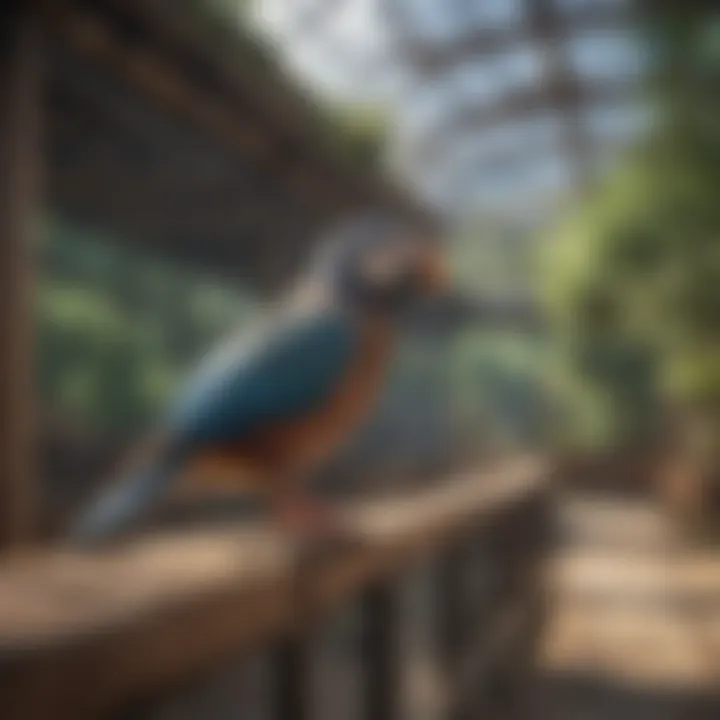
Providing environments conducive for these behaviors contributes to the overall happiness of birds.
Enhancing Bird Welfare
The welfare of birds in captivity depends on several factors, including environment, diet, and social connections. Large, well-designed aviaries help with enhanced welfare through various means.
- Space to Explore: Adequate space allows birds to explore. This exploration is crucial for their curiosity, avoiding boredom and associated problems.
- Nest Sites and Hiding Spots: An essential way to improve welfare is by incorporating various niches within aviaries. Projects such as using branches or nests mimic natural environments from where the birds came.
- Access to Light and Fresh Air: Aviaries also allow sunlight and clean air. Proper ventilation and access to daylight impact elemental health. It is vital to balance sun and shade for comfort.
In sum, large bird aviaries can sanctify a sanctuary that nurtures a bird's welfare effectively. Aviary arrangements that account for natural behaviors culminate in simple yet profound enrichments to birds and enviroments.
Challenges and Solutions
In any endeavor, challenges tend to arise. Large bird aviaries present their own set of unique difficulties. Understanding these inherent challenges is crucial for successful bird keeping. By anticipating issues and identifying effective solutions, bird owners and enthusiasts can create an environment that enhances both welfare for the birds and satisfaction for themselves.
Potential Hazards in Aviaries
Aviaries, while seemingly safe, have potential hazards that need consideration. Common hazards include:
- Predators: Even large birds can become targets for wildlife. It is critical to ensure that the aviary has secure, covered areas to protect the inhabitants from predators such as cats and raccoons.
- Hazardous Materials: The choice of materials used in the construction is vital. Certain paints and coatings may emit toxins. Likewise, sharp edges or cables can result in injury. Opt for bird-safe materials to avoid accidents.
- Space Constraints: Insufficient space can lead to conflict between birds. Territorial disputes may arise without adequate room for flighing and interaction. Ensure that your design considers comfortable space for each species you keep.
Taking into account these potential hazards helps form a foundation for a safe aviary. Bird keepers should assess their aviary environment frequently and make necessary adjustments to mitigate hazards.
It is recommended to conduct regular inspections of your aviary to identify and eliminate hazards promptly.
Managing Avian Stress
Substantial care must be extended towards managing stress in birds. Stress can have several causes, such as:
- Environmental Changes: Sudden changes in the aviary environment can cause anxiety. Keeping a consistent environment is notably important. Introduce alterations gradually and observe the birds’ reactions.
- Social Interactions: Every bird has its unique social needs. Clashing species may result in stressed behavior. Form compatible groups based on social hierarchies and other behavioral aspects to enhance overall harmony in the space.
Methods to counteract stress may include:
- Ensure Den Areas: Make sure legitimate hiding or den areas are included in the aviary. Quiet spots for birds to retreat help them feel secure as well as less anxious.
- Provide Diversions: Offer varied environmental enrichment. These include toys which may distract birds from stressors and also foster mental stimulation.
- Observe Regularly: Continuous observation enables you to recognize signs of stress or distress. Addressing issues promptly offers birds peace of mind.
In ensuring the overall health of the aviary community, prioritizing stress management is of utmost importance. Bird owners navigating challenges will distinguish themselves in the avian care context by advancing the welfare of the feathered residents they cherish.
Legal Considerations for Aviary Owners
Understanding the legal landscape when handling large bird aviaries is critical. Legal considerations not only ensure compliance with regulations but also help in the responsible ownership of avian species. Various regions may enforce different laws regarding animal ownership, permits, and welfare standards. It is crucial for aviary owners to stay informed about these laws to foster a safe and healthy environment for their birds.
Local Regulations and Permits
Local governance establishes rules that as an aviary owner, you must adhere to. There can be zoning laws that guide where you can keep an aviary. Some municipalities may have restrictions based on the types and numbers of birds you own. Research the municipal codes in your area to grasp these requirements fully.
Obtaining the appropriate permits is often necessary for construction and animal keeping. Here are essential steps to consider:
- Check Local Laws: Visit your local government websites to gather the necessary information.
- Contact Authorities: Reach out to local animal control or other relevant agencies. They can clarify specific requirements tailored to your location.
- Secure Permits: Depending on your area’s regulations, you may need a specific pet permit or an approval for the aviary dimensions.
Regulatory burdens can be manageable if properly recognized and planned, fostering compliance and nurturing avian welfare.
Ethical Responsibilities of Bird Owners
Ethics play a voie equally crucial role in aviary ownership. Being responsible is about ensuring environmental-sustainable practices and prioritizing the welfare of your birds. Integrated thinking as an owner involves assessing the broader implications of keeping birds.
Aviary owners must prioritize:
- Welfare Standards: Provide adequate space, nutrition, and healthcare. Ensure that birds have everything to thrive in their habitat.
- Conservation Efforts: Supporting local wildlife conservation and being wary of keeping endangered species from the wild without specific breeding permits can help protect natural populations.
- Connecting with the Community: Listening to the voices of wildlife rescue groups and other community organizations can keep you informed of their needs and support important causes.
Overall, embracing your ethical responsibilities doesn't merely protect your birds; it safeguards their life. Both legal stipulations and ethical commitments enrich the quality of life for birds, ensuring their needs are met and recognized constantly.
Sharing Your Aviary Experience
Sharing your experience in maintaining and caring for a large bird aviary is beneficial to both current and future bird owners. It allows for the exchange of valuable insights, encourages community engagement, and fosters a support network that can enhance the overall practice of avian care.
Bird ownership brings unique challenges and rewards. When owners share their experiences, they outline real-life scenarios that can direct others in similar situations. Whether it is lessons learned during the construction of an aviary, successful bird introductions, or engaging enrichment strategies, sharing helps demystify the often complex processes involved in aviary management.
Moreover, partaking in discussions and sharing stories in varied forums or platforms leads to a more informed community. This can prevent mistakes caused by lack of information and promote higher standards of care. Community input often illuminates perspectives that personal research might miss, compeling bird owners to discover diverse methodologies and viewpoints.
While every experience is unique, the insights shared by other bird lovers form an invaluable web of knowledge that can significantly uplift aviary practices.
Joining Aviary Communities
Joining aviary communities opens doors to friendships, support groups, and knowledge exchange among enthusiasts. Online platforms such as forums on Reddit, or Facebook groups, allow individuals to connect with like-minded individuals. These platforms provide inclusive environments, so members can ask questions and receive constructive feedback.
The community extends beyond the digital world. Attending meet-ups and seminars gives bird owners the opportunity to interact face-to-face. Shared experiences can lead to better understanding of specific issues or concerns. Often, local bird clubs organize events that permit insights into aviary design and species compatibilities which prove beneficial to both novice and seasoned aviary owners.
Documenting Your Aviary Journey
Documenting your aviary journey serves as an invaluable personal reference and a way to contribute to the broader community. Journaling day-to-day changes, challenges faced, or even successful interventions creates a timeline that mirrors personal growth as an owner.
Through photographs and written accounts, bird owners can track progress over time. Details about bird behavior or changes in environment can provide clarity when seeking advice from others. This documentation can later be used as informative material within forums, social media postings, or any publication focusing on gorgeous aviaries and shared experiences.
An added benefit is the sense of accomplishment derived from reflecting on your journey. Individuals realize they are not alone in their endeavors. With time, you might inspire others to embark on their aviary voyage, contributing positively backward to the community as well.
Future Trends in Aviary Design
Understanding the evolution of aviary design and the trends shaping its future is crucial for advancing the well-being of birds in captive environments. These new designs consider not only the aesthetic appeal but also the habitats that mimic birds' natural environments. Embracing modern trends in aviary construction contributes to healthier avian populations and fosters a deeper engagement with their ecosystem. The continuing innovation in this field provides opportunities to create more sustainable, interconnected, and enriching experiences for birds and their owners alike.
Sustainable Practices in Aviary Management
Sustainability is rapidly becoming a cornerstone in aviary management. Owners are increasingly inclined to use eco-friendly materials and renewable resources during construction. This proactive approach encompasses several aspects:
- Habitat Conservation: Sustainable practices help reduce the negative impact on natural habitats.
- Energy Efficiency: Utilizing solar panels or other sustainable energy sources minimizes energy consumption.
- Water Management: Implementing rainwater harvesting systems can greatly benefit the care of birds while also using local resources wisely.
By prioritizing sustainability, aviary managers can create environments that support biodiversity and environmental health. This does not mean compromising functionality. Rather, sustainable choices often enhance the living conditions for the birds.
“Incorporating sustainable practices is not only an ethical choice, but it enhances the long-term resilience of your aviary.”
Innovative Materials and Technologies
The future of aviary design will significantly depend on the development and application of innovative materials and technologies. Custom solutions can make aviaries safer and more adaptable. Consider the following innovations:
- Recycled Materials: Items made from recycled resources can lessen reliance on new ones. Many owners are now using plastic lumber and repurposed metals for durability and longevity.
- Smart Technologies: Implementing sensors and automation can help monitor various aspects of an aviary's environment, such as humidity and temperature levels, ensuring optimal conditions without constant manual oversight.
- Lightweight Structures: Advanced polymer materials that are both lightweight and strong allow for larger aviary frameworks while ensuring resistance to the rigors of weather.
Innovation does not only respond to functionality but seeks to inspire the form of aviaries, enhancing both the aesthetic and practical aspects of avian habitats. As more people understand the benefits of these advanced technologies, their adoption may increase across aviaries worldwide, setting new standards for the bird-keeping community.















